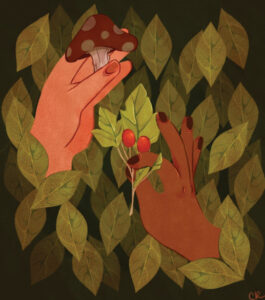The snow is melting, trees are beginning to bud, and the sun is peeking out a tad bit more than it has for the past few months. While it may not officially be the Spring Equinox until March 21, the vaguely warmer weather and knee-high mud are good signs of one of the biggest foraging seasons of the year. Spring is filled with many things: leaves, flowers, as well as many species of mushrooms.
As with any pastime, there are rules, general advice, and etiquette to follow when foraging for wild edibles in Atlantic Canada. One rule is t, only harvest as much as you need and no more. This means rationing, measuring, and leaving plenty behind. Any ecosystem is a delicate force, and must be protected. Another rule is to make yourself hyper-aware of edible lookalikes and poisonous species. While there will be some identifying factors in this article to help you avoid picking the wrong foragable, the best option is to consult local experts, online or literary resources, or to download reliable apps specially designed for identifying plants and fungi.
Of course, while mushrooms are perhaps the most exhilarating foragable given their mysterious personas and their possible lookalikes, it would be remiss not to mention the bud New Brunswick is most famous for: fiddleheads. Fiddleheads, like many mushrooms, do have dangerous lookalikes. However, if you know what to look for, it can be exciting to find them. True fiddleheads can be identified by U-shaped stalks when cut (like celery stalks), as well as the papery-brown leaves that rub off of them when picked. Lookalikes will not have the U-shape and will have little hairs, while the true fiddleheads do not have hairs. Fiddleheads can often be found near the Miramichi, Tobique, Restigouche, and Saint John rivers. They have been described as tasting similar to asparagus, broccoli, and other greens, and can be sauteed in garlic butter or boiled and put in a classic fiddlehead soup or vegetable medley.
Soon, dandelions will begin sprouting from the ground. These weeds are easy to spot and are often discarded as everyone begins prepping their gardens for viewing pleasure. However, despite their status as weeds, dandelions are edible and can be used in many recipes, from tea to ice cream. The good news about dandelions is that there are no major lookalikes to be worried about, and their availability makes it hard to experiment with their many fun attributes. An important thing to know about harvesting dandelions is that the whole plant is beneficial. Their leaves can be added to salads, although older leaves may taste quite bitter compared to richer, younger leaves. To reduce the bitter flavour, the greens can be boiled down and included as a substitute for other green vegetables in soups, stews, and other dishes. The root and the flower petals can both be used to make a dandelion tea, which only requires you to boil the both of them in water with any other flavours you wish. The flower can also be used in homemade ice cream, dandelion fritters, enjoyed raw, and in many other recipes.
Spring also has its fair share of seasonal fungi fun-guys. One of the most common spring specimens are the Fairy Ring Mushrooms, which grow in grassy areas like backyards, forests, glades, or practically anywhere with greenery. They look like standard mushrooms: tan, with a 6cm cap and long thin stalks. They are pliant, so if you were to test them and wrap the stalks around your finger, a Fairy Ring stalk will not break. The gills on the underside of the cap are widely spread apart, not clustered too close together. Given the fact that they are classified as Little Brown Mushrooms (LBMs), a category that is quite extensive and contains a lot of similar looking mushrooms, it would be best to consult several guides and local experts before harvesting. While there are many species of Fairy Ring mushrooms, and several are not only edible, but highly delicious, there are also a few lookalikes to be wary of, and it is better to be safe than sorry in the case of fungi. On that note, fungi are particularly sensitive to chemicals in the environment, so if you find any Fairy Ring mushrooms near a road, it would be best to leave them be, as they may have absorbed toxins from passing cars and may not be suitable for eating. Fairy Ring mushrooms have a subtle taste and an even more subtle aroma, and can be used in practically any recipe that calls for white-cap or sauteed mushrooms.

There are many more foragable spring edibles out there, and you can use them for practically anything from salads, pastas, and desserts to soaps, candles, and homemade perfumes. Please remember to be incredibly careful when foraging, and if you’re heading to areas that may be populated with poison oak and ivy, be sure to wear long pants, long socks, and gloves. If you have the right plant-identification sources at your disposal, you will do amazing. Foraging, while scary and daunting at first, can be incredibly fulfilling and may open doors for interesting food experiments. Remember to leave plenty behind when picking plants and fungi, and to respect the environment. Good luck on all your foraging endeavours, and be sure to share with friends!





